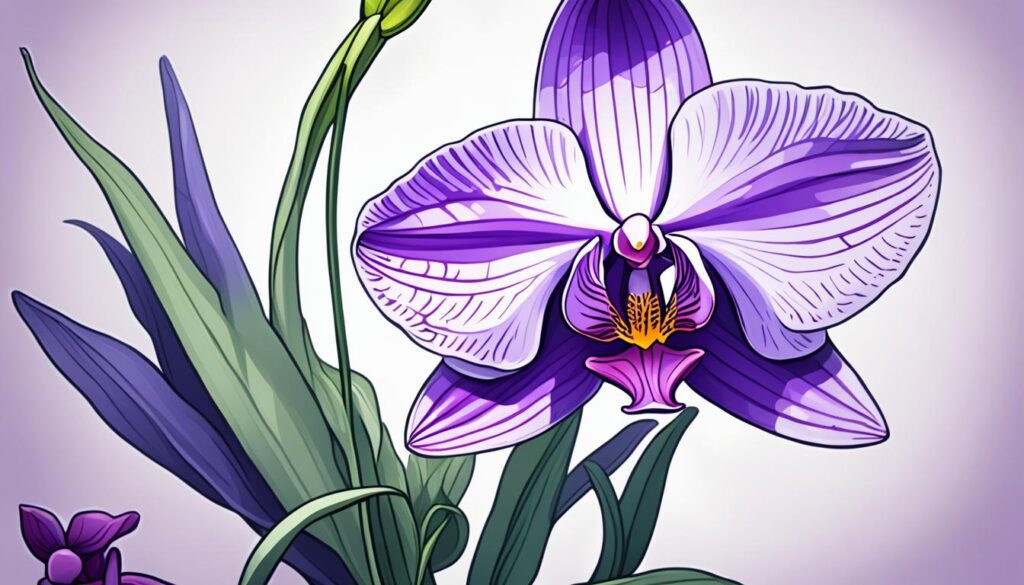As orquídeas são plantas verdadeiramente fascinantes, capazes de adicionar elegância e encanto a qualquer ambiente. Neste artigo, iremos mergulhar no maravilhoso mundo das orquídeas, explorando sua beleza, diversidade e os cuidados necessários para mantê-las saudáveis e floridas em nossas casas.
Seja você um apaixonado por orquídeas ou um iniciante nessa jornada, este artigo irá guiá-lo através das características únicas das espécies raras de orquídeas, apresentando as principais espécies e suas origens. Além disso, vamos abordar a importância da escolha da orquídea perfeita para sua residência, levando em consideração fatores como iluminação e temperatura.
Mas não pára por aí! Também exploraremos os mitos e fatos sobre a rega adequada, além de desvendar os segredos da nutrição e fertilização para manter suas orquídeas saudáveis e vigorosas. E, claro, aprenderemos a prevenir e tratar pragas e doenças que possam acometer essas belas plantas.
Junte-se a nós nesta emocionante aventura de cuidar e cultivar orquídeas em sua própria casa. Prepare-se para descobrir a beleza e a diversidade desses fascinantes seres vegetais!
The Fascinating World of Orchids: An Introduction to Their Beauty and Diversity
Orchids are among the most captivating plants in the world, renowned for their exquisite beauty and remarkable diversity. With over 25,000 known species found across the globe, excluding Antarctica, these flowers can be discovered on nearly every continent. Their vast array of colors, shapes, and sizes make them a popular choice for decorating homes and gardens. Moreover, orchids hold a rich cultural and symbolic history in many ancient civilizations.
Unique Characteristics of Rare Orchids
Rare Orquídeas raras are particularly fascinating, often showcasing unique features that set them apart from their more common counterparts. These características de orquídeas raras can include intricate petal designs, unusual growth patterns, and even the ability to thrive in harsh or specialized environments. Understanding the características de orquídeas raras is crucial for appreciating the remarkable diversity of the orchid family.
Major Species of Rare Orchids and Their Origins
The world of Orquídeas raras is vast and diverse, with numerous espécies de orquídeas raras found in various regions across the globe. Some of the most captivating rare orchid species include the Orquídeas endêmicas and the Orquídeas ameaçadas de extinção, which often thrive in unique habitat natural de orquídeas raras. Exploring the origins and habitats of these rare orchids provides valuable insights into the complex and intriguing world of these magnificent flowers.

“The orchid’s beauty and mystery lies in its delicate, but resilient nature – a true testament to the wonders of the natural world.”
Choosing the Perfect Orchid for Your Home
When it comes to selecting the right orchid for your home, there are several factors to consider to ensure its successful adaptation and survival in the right environment. The first step is to evaluate the available space in your home, as orchids come in a variety of sizes and shapes. Additionally, you should decide whether you prefer an orchid that blooms once a year or multiple times, and if you have a specific fragrance in mind.
Another crucial consideration is the amount of light the plant will receive in its designated location. Some orchid varieties require ample direct sunlight, while others thrive in more shaded environments. The temperature of the room where the orchid will be placed is also essential, as some species prefer warmer climates, while others need cooler temperatures to bloom properly.
- Escolha de orquídeas para casa: Consider the available space, bloom frequency, and fragrance preferences.
- Fatores a considerar na escolha de orquídeas: Evaluate light and temperature requirements for the desired location.
- Tamanho de orquídeas: Choose an orchid that fits the size of the space in your home.
- Necessidades de luz de orquídeas: Ensure the orchid receives the appropriate amount of sunlight.
- Necessidades de temperatura de orquídeas: Select an orchid that thrives in the temperature range of the room.
Lastly, it’s important to choose a healthy, high-quality orchid, avoiding those with yellowed leaves or foliar spots. By taking these factors into account, you can confidently select the perfect orchid to bring the beauty and elegance of these fascinating plants into your home.

Orquídeas: Nurturing and Caring for These Exquisite Plants
Cultivating and caring for orquídeas requires a delicate balance of factors, from light and temperature to watering and fertilization. By understanding the unique needs of these enchanting flowers, you can help them thrive and blossom in your home or garden.
The Importance of Light and Temperature in Orchid Care
Providing the right amount of light is crucial for the health and growth of orquídeas. These plants prefer bright, indirect light, as direct sunlight can scorch their delicate leaves. Placing them in a spot where they receive several hours of sunlight each day, but are shielded from the harshest rays, is ideal.
Temperature is another critical element in orchid care. Most orquídeas thrive in warm, humid environments, with daytime temperatures ranging from 20 to 25 degrees Celsius and slightly cooler nights, around 15 to 18 degrees Celsius. Maintaining this temperature balance is essential for the plants to flourish.
Proper Watering: Myths and Facts About Water for Orchids
One of the most common misconceptions about orquídeas is the frequency of watering. Contrary to popular belief, these plants do not require daily watering. In fact, overwatering can be detrimental, leading to root rot and other issues. The ideal watering schedule is to allow the potting medium to partially dry out between waterings, typically every 5-7 days.
When watering orquídeas, it’s essential to use lukewarm, purified water and avoid letting the roots sit in water. This can help prevent the buildup of salts and minerals that can harm the plants.
Nutrition and Fertilization: Secrets to Keep Your Orchids Healthy
Orquídeas require a balanced fertilizer to maintain their vibrant appearance and robust growth. Look for a specialized orchid fertilizer that provides a mix of essential nutrients, such as nitrogen, phosphorus, and potassium. Apply the fertilizer according to the manufacturer’s instructions, typically every 2-4 weeks during the growing season.
Proper nutrition not only keeps orquídeas healthy but also helps prevent the onset of pests and diseases. By providing your plants with the right fertilizers, you can ensure they thrive and continue to captivate with their stunning blooms.
Prevention and Treatment of Pests and Diseases in Orchids
While orquídeas are generally hardy plants, they can occasionally fall victim to pests and diseases. Common issues include mealybugs, scale insects, and fungal infections. To prevent and treat these problems, it’s essential to regularly inspect your plants, address any issues promptly, and maintain good cultural practices, such as proper watering, lighting, and air circulation.
By staying vigilant and addressing any problems early on, you can help your orquídeas overcome pests and diseases and continue to flourish in your home or garden.
Conclusion
Cultivating orchids is a beautiful journey, filled with both challenges and joys. With an incredible variety of colors and forms, these exotic flowers are perfect for those who desire a diverse and vibrant garden in their home. By following the tips and care instructions presented in this guide, you can transform your living space into a true botanical paradise, nurturing the beauty and charm of orchids.
Even with some challenges along the way, the dedicated effort put into growing these plants is amply rewarded by the sight of their exuberant blooms. So, embrace the beauty of orchids and let your space become even more elegant and harmonious. Cultivate the enchantment of orchids and witness your home blossom into a verdant oasis.
The world of orchids is vast and captivating, offering a wealth of opportunities for both novice and experienced gardeners. Whether you’re drawn to the rare and unique species or the more common yet stunning varieties, there’s an orchid that can bring a touch of elegance and tranquility to your living environment. Embark on this horticultural adventure and let the orchids elevate your space with their unparalleled allure.
FAQ
What makes orchids such fascinating and beautiful plants?
Orchids are one of the most fascinating plants in the world, thanks to their beauty and diversity. With over 25,000 known species worldwide, these flowers can be found on almost every continent except Antarctica. Their wide variety of colors, shapes, and sizes make them a popular choice for decorating homes and gardens. Orchids also have a rich cultural and symbolic history in many ancient cultures.
What factors should I consider when choosing an orchid for my home?
When choosing an orchid for your home, it’s important to consider several factors that ensure its adaptation and survival in the right environment. First and foremost, you need to consider the available space in your home, as orchids come in different sizes and shapes. Additionally, you should know if you prefer an orchid that blooms once or multiple times a year, and if you would like a variety with a specific fragrance. Another important consideration is the amount of light the plant will receive in the location where it will be placed. Some orchids require a lot of direct sunlight, while others prefer shadier environments. It’s also crucial to consider the temperature of the environment where the orchid will be placed, as some varieties prefer warmer climates, while others need cooler temperatures to bloom properly. Finally, it’s important to choose a healthy, high-quality orchid, avoiding those with yellowing leaves or foliar spots.
How important are light and temperature in caring for orchids?
Light and temperature are fundamental factors in orchid care. These beautiful plants need the right amount of light to bloom and grow healthily. It’s important to place them in a location where they receive indirect light and avoid direct sunlight exposure, as this can burn their delicate foliage. When it comes to temperature, you need to maintain the right balance. Most orchids prefer warm temperatures during the day, around 20-25 degrees Celsius, and slightly cooler temperatures at night, around 15-18 degrees Celsius.
How can I properly water and fertilize my orchids?
Proper watering and fertilization are crucial for keeping your orchids healthy and thriving. It’s important to avoid overwatering, as this can lead to root rot and other problems. Instead, water your orchids when the potting mix is partially dry, being careful not to let them sit in water. When it comes to fertilization, use a balanced, orchid-specific fertilizer and follow the instructions carefully. Providing the right nutrients at the right time can help your orchids produce vibrant blooms and strong, healthy growth.
How can I prevent and treat pests and diseases in my orchids?
Keeping an eye out for pests and diseases is an important part of orchid care. Common issues include aphids, mealybugs, scale insects, and fungal diseases. To prevent these problems, maintain good air circulation, avoid overwatering, and regularly inspect your orchids for any signs of trouble. If you do encounter pests or diseases, act quickly to treat them with appropriate insecticides or fungicides, following the product instructions carefully. With diligent monitoring and prompt action, you can keep your orchids healthy and thriving.
What are some tips for propagating and growing new orchids?
Growing new orchids from your existing plants can be a rewarding experience. Look for keikis (baby orchids) that form on the flower spikes or stems, and carefully detach and pot them up. You can also divide mature orchid plants, making sure each division has healthy roots and leaves. Additionally, some orchids can be propagated from seed, though this requires more specialized knowledge and equipment. With the right techniques and patience, you can expand your orchid collection and share the beauty of these plants with others.